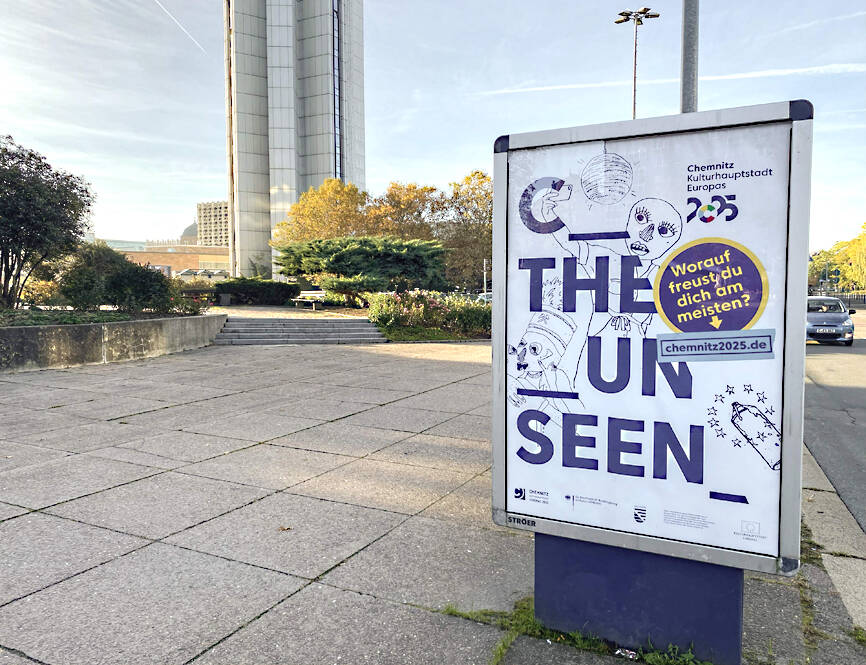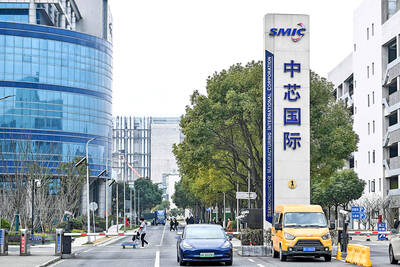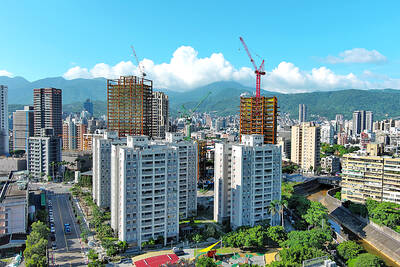Known as Karl-Marx-Stadt under communism and later a notorious hotspot for far-right violence, the eastern German city of Chemnitz is now seeking to reinvent itself as a 2025 European Capital of Culture.
Chemnitz plans to welcome about 2 million visitors to 150 arts and cultural projects this year, including museum exhibits and a colorful mix of music, theatre, film and dance shows.
The festivities, themed “C The Unseen,” seek to highlight the cosmopolitan side of the city of 250,000 people in Saxony that tends to be overshadowed by the bigger eastern urban centers of Dresden and Leipzig.

Photo: AFP
The year-long program would include panel talks, street chess, queer culture, toy-making, a cooking marathon and a new opera with a libretto written by Booker Prize-winning author Jenny Erpenbeck.
Chemnitz Mayor Sven Schulze hopes the extravaganza would change perceptions about Chemnitz, where in 2018 right-wing extremists were accused of hunting down migrants through the streets between drab Cold War-era prefabricated housing blocks.
“Chemnitz is a city that often finds itself in the shadows, that is underestimated, that has experienced many disruptions in recent decades,” said Schulze, from the Social Democratic Party of German Chancellor Olaf Scholz.
“As a capital of Culture, we want to shine a spotlight on this city, on its unseen potential, on its people,” he said.
However, not everyone in Chemnitz is on board with the planned rebrand, which has poured new fuel into combustible culture wars raging far beyond the city ahead of a general election next month.
Right-wing groups in the city council last year introduced a motion calling for Chemnitz 2025 to be canceled, calling it “delusional” and an “embarrassment.”
They slammed the project as a waste of taxpayer money at a time when many locals are financially struggling, and plan a demonstration against it on the launch date, Saturday next week.
Chemnitz, a 19th-century textile industry hub once known as the “Manchester of Saxony” state has a turbulent history.
Communist East Germany renamed it Karl-Marx-Stadt in 1953, and a giant bronze monument of his head was erected in the city center before the inscription “Workers of the World, Unite!”
After the Berlin Wall fell in 1989, Chemnitz was battered by the closing of factories, sweeping job losses and a population decline, like much of the rest of the region.
As elsewhere, disorientation and discontent fueled xenophobia and right-wing extremism.
In 2018, tensions boiled over when a Syrian immigrant killed a German man in the city, provoking days of protests that turned into violent riots.
The far-right Alternative for Germany has found strong support in Chemnitz and scored 26 percent of the vote in the city at regional elections in September last year.
Lawyer Martin Kohlmann, 47, a founding member of the “Freie Sachsen” (Free Saxons) secessionist movement and of the right-wing populist group Pro Chemnitz, was among those who took to the streets in 2018.
He believes the money for Chemnitz 2025 would be better spent to “make the city nice for its own people and not attract tourists and investors and whoever else.”
Local people want to see investment in “museums, swimming pools, public transport,” rather than for “some kind of circus coming to town,” Kohlmann said.
Chemnitz wants to move on from the “huge shock” of 2018, said Anja Richter, head of the city’s Gunzenhauser museum and art gallery.
“We are all trying to leave that behind us, to shake it off and do something about it, especially in the cultural scene,” she said.
However, in the run-up to Chemnitz 2025, many arts and culture organizations have found themselves targeted by far-right activists. A recent local government report said arts groups had been subjected to “political pressure, defamation and threats in social networks, open threats, disruption of events and physical assault.”
In response, Chemnitz 2025 would also include projects meant to tackle right-wing extremism.
A new documentation center would focus on the crimes of a murderous neo-Nazi militant group active in the early 2000s called the National Socialist Underground.
Pubs, restaurants and other sites that support the cultural events would welcome visitors with special stickers labeling them “allies” of Chemnitz 2025.
Schulze said that “we are doing a lot to ensure that no one has to be afraid of coming to Chemnitz.”
Curator Agnieszka Kubicka-Dzieduszycka — who runs a project showcasing garages that have housed iconic “Trabi” cars — said that “of course I am concerned about what will happen on Jan. 18.”
However, “I believe there will be more of us,” she added optimistically about the festival’s supporters.

NO BREAKTHROUGH? More substantial ‘deliverables,’ such as tariff reductions, would likely be saved for a meeting between Trump and Xi later this year, a trade expert said China launched two probes targeting the US semiconductor sector on Saturday ahead of talks between the two nations in Spain this week on trade, national security and the ownership of social media platform TikTok. China’s Ministry of Commerce announced an anti-dumping investigation into certain analog integrated circuits (ICs) imported from the US. The investigation is to target some commodity interface ICs and gate driver ICs, which are commonly made by US companies such as Texas Instruments Inc and ON Semiconductor Corp. The ministry also announced an anti-discrimination probe into US measures against China’s chip sector. US measures such as export curbs and tariffs

The US on Friday penalized two Chinese firms that acquired US chipmaking equipment for China’s top chipmaker, Semiconductor Manufacturing International Corp (SMIC, 中芯國際), including them among 32 entities that were added to the US Department of Commerce’s restricted trade list, a US government posting showed. Twenty-three of the 32 are in China. GMC Semiconductor Technology (Wuxi) Co (吉姆西半導體科技) and Jicun Semiconductor Technology (Shanghai) Co (吉存半導體科技) were placed on the list, formally known as the Entity List, for acquiring equipment for SMIC Northern Integrated Circuit Manufacturing (Beijing) Corp (中芯北方積體電路) and Semiconductor Manufacturing International (Beijing) Corp (中芯北京), the US Federal Register posting said. The

India’s ban of online money-based games could drive addicts to unregulated apps and offshore platforms that pose new financial and social risks, fantasy-sports gaming experts say. Indian Prime Minister Narendra Modi’s government banned real-money online games late last month, citing financial losses and addiction, leading to a shutdown of many apps offering paid fantasy cricket, rummy and poker games. “Many will move to offshore platforms, because of the addictive nature — they will find alternate means to get that dopamine hit,” said Viren Hemrajani, a Mumbai-based fantasy cricket analyst. “It [also] leads to fraud and scams, because everything is now

MORTGAGE WORRIES: About 34% of respondents to a survey said they would approach multiple lenders to pay for a home, while 29.2% said they would ask family for help New housing projects in Taiwan’s six special municipalities, as well as Hsinchu city and county, are projected to total NT$710.65 billion (US$23.61 billion) in the upcoming fall sales season, a record 30 percent decrease from a year earlier, as tighter mortgage rules prompt developers to pull back, property listing platform 591.com (591新建案) said yesterday. The number of projects has also fallen to 312, a more than 20 percent decrease year-on-year, underscoring weakening sentiment and momentum amid lingering policy and financing headwinds. New Taipei City and Taoyuan bucked the downturn in project value, while Taipei, Hsinchu city and county, Taichung, Tainan and Kaohsiung